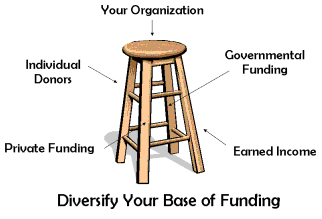Progression Tracker
Introduction
Do You Need a Funding Plan?
Introduction to the Six Steps
Step 1: Establish Priorities
Step 2: Assess Capacity
Step 3: Set Fundraising Goals
Step 4: Identify Funding Sources
Step 5: Evaluate & Select Funding Sources
Final Quiz
Sample Finance Plans
List of Case Studies
References & Additional Resources
Do You Need a Funding Plan?
Introduction to the Six Steps
Step 1: Establish Priorities
Step 2: Assess Capacity
Step 3: Set Fundraising Goals
Step 4: Identify Funding Sources
Step 5: Evaluate & Select Funding Sources
- Fundraising Environment
- Diversification
- Estimated Returns
- Sustainability
- Key Evaluation Questions
Final Quiz
Sample Finance Plans
List of Case Studies
References & Additional Resources
Step 5 (continued). Diversify your Sources
 Watershed
organizations should pursue a variety of funding sources to support their projects.
Groups that rely on a single source, such as government grants, place themselves
in a vulnerable position. As your organization starts growing, think about diversifying
to a few reliable sources.
Watershed
organizations should pursue a variety of funding sources to support their projects.
Groups that rely on a single source, such as government grants, place themselves
in a vulnerable position. As your organization starts growing, think about diversifying
to a few reliable sources.
In choosing diverse funding sources, do your research: know what works in your area, what other groups may be competing for funding, and what resources are available. As mentioned in Step 1, look to your mission and strategic plan for developing fundraising ideas that would complement your organization's vision.
![[logo] US EPA](https://www.epa.gov/epafiles/images/logo_epaseal.gif)